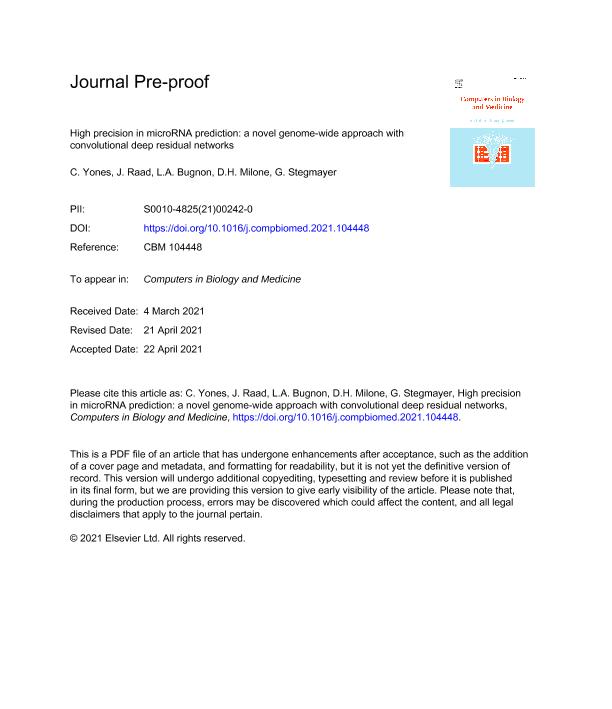Mostrar el registro sencillo del ítem
dc.contributor.author
Yones, Cristian Ariel

dc.contributor.author
Raad, Jonathan

dc.contributor.author
Bugnon, Leandro Ariel

dc.contributor.author
Milone, Diego Humberto

dc.contributor.author
Stegmayer, Georgina

dc.date.available
2023-01-12T09:30:48Z
dc.date.issued
2021-07
dc.identifier.citation
Yones, Cristian Ariel; Raad, Jonathan; Bugnon, Leandro Ariel; Milone, Diego Humberto; Stegmayer, Georgina; High precision in microRNA prediction: a novel genome-wide approach with convolutional deep residual networks; Pergamon-Elsevier Science Ltd; Computers In Biology And Medicine; 134; 7-2021; 1-14
dc.identifier.issn
0010-4825
dc.identifier.uri
http://hdl.handle.net/11336/184441
dc.description.abstract
MicroRNAs (miRNAs) are small non-coding RNAs that have a key role in the regulation of gene expression. The importance of miRNAs is widely acknowledged by the community nowadays and computational methods are needed for the precise prediction of novel candidates to miRNA. This task can be done by searching homologous with sequence alignment tools, but results are restricted to sequences that are very similar to the known miRNA precursors (pre-miRNAs). Besides, a very important property of pre-miRNAs, their secondary structure, is not taken into account by these methods. To fill this gap, many machine learning approaches were proposed in the last years. However, the methods are generally tested in very controlled conditions. If these methods were used under real conditions, the false positives increase and the precisions fall quite below those published. This work provides a novel approach for dealing with the computational prediction of pre-miRNAs: a convolutional deep residual neural network (mirDNN). This model was tested with several genomes of animals and plants, the full-genomes, achieving a precision up to 5 times larger than other approaches at the same recall rates. Furthermore, a novel validation methodology was used to ensure that the performance reported in this study can be effectively achieved when using mirDNN in novel species. To provide fast an easy access to mirDNN, a web demo is available at http://sinc.unl.edu.ar/web-demo/mirdnn/. The demo can process FASTA files with multiple sequences to calculate the prediction scores and generates the nucleotide importance plots.
dc.format
application/pdf
dc.language.iso
eng
dc.publisher
Pergamon-Elsevier Science Ltd

dc.rights
info:eu-repo/semantics/openAccess
dc.rights.uri
https://creativecommons.org/licenses/by-nc-sa/2.5/ar/
dc.subject
DEEP LEARNING
dc.subject
GENOME-WIDE
dc.subject
MICRORNA PREDICTION
dc.subject.classification
Ciencias de la Información y Bioinformática

dc.subject.classification
Ciencias de la Computación e Información

dc.subject.classification
CIENCIAS NATURALES Y EXACTAS

dc.title
High precision in microRNA prediction: a novel genome-wide approach with convolutional deep residual networks
dc.type
info:eu-repo/semantics/article
dc.type
info:ar-repo/semantics/artículo
dc.type
info:eu-repo/semantics/publishedVersion
dc.date.updated
2022-10-28T19:19:24Z
dc.journal.volume
134
dc.journal.pagination
1-14
dc.journal.pais
Estados Unidos

dc.description.fil
Fil: Yones, Cristian Ariel. Consejo Nacional de Investigaciones Científicas y Técnicas. Centro Científico Tecnológico Conicet - Santa Fe. Instituto de Investigación en Señales, Sistemas e Inteligencia Computacional. Universidad Nacional del Litoral. Facultad de Ingeniería y Ciencias Hídricas. Instituto de Investigación en Señales, Sistemas e Inteligencia Computacional; Argentina
dc.description.fil
Fil: Raad, Jonathan. Consejo Nacional de Investigaciones Científicas y Técnicas. Centro Científico Tecnológico Conicet - Santa Fe. Instituto de Investigación en Señales, Sistemas e Inteligencia Computacional. Universidad Nacional del Litoral. Facultad de Ingeniería y Ciencias Hídricas. Instituto de Investigación en Señales, Sistemas e Inteligencia Computacional; Argentina
dc.description.fil
Fil: Bugnon, Leandro Ariel. Consejo Nacional de Investigaciones Científicas y Técnicas. Centro Científico Tecnológico Conicet - Santa Fe. Instituto de Investigación en Señales, Sistemas e Inteligencia Computacional. Universidad Nacional del Litoral. Facultad de Ingeniería y Ciencias Hídricas. Instituto de Investigación en Señales, Sistemas e Inteligencia Computacional; Argentina
dc.description.fil
Fil: Milone, Diego Humberto. Consejo Nacional de Investigaciones Científicas y Técnicas. Centro Científico Tecnológico Conicet - Santa Fe. Instituto de Investigación en Señales, Sistemas e Inteligencia Computacional. Universidad Nacional del Litoral. Facultad de Ingeniería y Ciencias Hídricas. Instituto de Investigación en Señales, Sistemas e Inteligencia Computacional; Argentina
dc.description.fil
Fil: Stegmayer, Georgina. Consejo Nacional de Investigaciones Científicas y Técnicas. Centro Científico Tecnológico Conicet - Santa Fe. Instituto de Investigación en Señales, Sistemas e Inteligencia Computacional. Universidad Nacional del Litoral. Facultad de Ingeniería y Ciencias Hídricas. Instituto de Investigación en Señales, Sistemas e Inteligencia Computacional; Argentina
dc.journal.title
Computers In Biology And Medicine

dc.relation.alternativeid
info:eu-repo/semantics/altIdentifier/url/https://linkinghub.elsevier.com/retrieve/pii/S0010482521002420
dc.relation.alternativeid
info:eu-repo/semantics/altIdentifier/doi/http://dx.doi.org/10.1016/j.compbiomed.2021.104448
Archivos asociados
